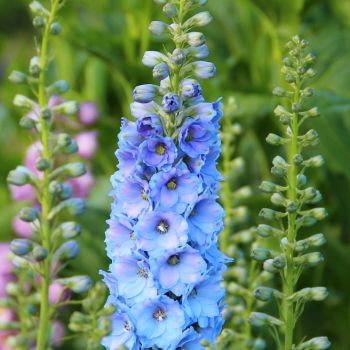Lilies are fabulous additions to the summer garden, providing height to borders and colour and fragrance in the hottest time of the year. In Australia many lilies bloom around Christmas time, just when many gardeners want to show off their gardens to best effect.
There are at least 90 species of lilies and hundreds more hybrids (a lily produced by interbreeding two different parents), with new ones being released each year. This can make choosing the right lily for your garden a little confusing. Learning about the different types of lily can make your choice easier, and will give you an idea of the type of flower and level of fragrance you can expect from your bulbs.
Lilies are classified into 9 groups, called 'divisions'. Each division includes flowers with similar parentage, flower characteristics, bloom times and stem heights.
The good news is that the basic growing instructions for all lilies is the same. While some divisions (martagon and species lilies in particular) have a reputation for being tricky to establish, hybrid varieties have usually been selected for resilience and are easy for home gardeners to grow. If you're new to growing lilies, the easiest varieties to grow are Asiatics, Orientals and Interdivisional hybrids.
Here's a brief description of each of the 9 lily divisions:
1. Asiatic Hybrids
Asiatic hybrids are among the easiest lilies to grow and the first to flower, blooming from late spring to mid-summer. Plants generally grow 90-120cm tall with four to five flowers per stem from young bulbs, and up to 20 flowers from mature bulbs. The flowers are 10-12cm wide and can face up, down or outwards. Flowers have light to no fragrance.

2. Martagon Hybrids
Also called ‘Turk’s Cap’ lilies, martagons bloom early in the season with numerous small, downwards-facing flowers on tall stems. Martagons have a reputation for being difficult to establish but will naturalise and bloom for years in the dappled shade of a woodland garden.

3. Candidum Hybrids
Candidum hybrids are a small group of lilies bred from European species and including Madonna Lilies. They are not as commonly grown as other types of lily.

4. American Hybrids
American hybrid lilies are just that: hybrids developed from species native to North America. The small flowers generally face downwards with recurved petals and prominent anthers. American hybrids can be difficult to establish and are not as commonly grown as other types of lily.

5. Longiflorum Hybrids
Also known as ‘Easter Lilies’, longiflorum hybrids have trumpet-shaped, outward facing flowers measuring 15-18cm across that bloom mid to late summer. The flowers are usually pure white and highly fragrant, with 12-15 flowers per 60-90cm tall stem.

6. Trumpet and Aurelian Hybrids
Trumpet and Aurelian hybrids have distinctive trumpet shaped flowers, often in white or subtle pastel colours, many with a contrasting throat or colour bars. Blooming on tall stems, the flowers are waxy, highly fragrant and 15-20cm across, with up to 25 flowers per stem from mature bulbs.

7. Oriental Hybrids
Oriental hybrids are the rock stars of the lily world, with single or double flowers in vivid white, pink and purple often with contrasting colour bars or spots. The flowers bloom on 120-150cm tall stems and are brilliantly fragrant, growing 15-18cm wide and generally facing upwards. Oriental hybrids bloom late in the season (mid-summer to autumn) and prefer a slightly acidic soil.

8. Interdivisional Hybrids
This is a ‘catch all’ group including all hybrids developed by crossing parents from two of the other divisions. This breeding is generally done to combine characteristics of the parent plants, for example marrying a highly scented variety with a large or unusually coloured one. This division also includes 'pot' or 'pixie' varieties especially selected for short stems. The three main subgroups in this division are:
- LA hybrids, developed from crossing Longiflorum and Asiatic varieties
- OT hybrids, developed from crossing Oriental and Trumpet varieties
- OA or AOA hybrids, developed from crossing Oriental and Asiatic varieties.

9. Species Lilies
This group includes about 90 wild lily species that are the parents of all the hybrid groups. Most species lilies have small, delicate flowers, and while some are easy to grow, others can be challenging. The group includes the species form of orange tiger lilies.

Which lily will you choose for your garden?





